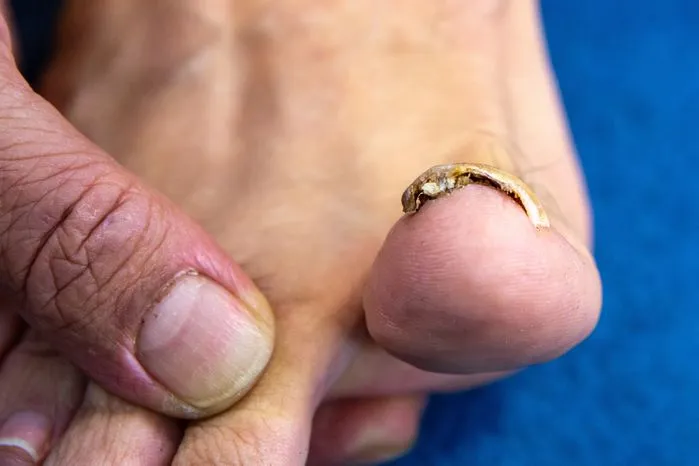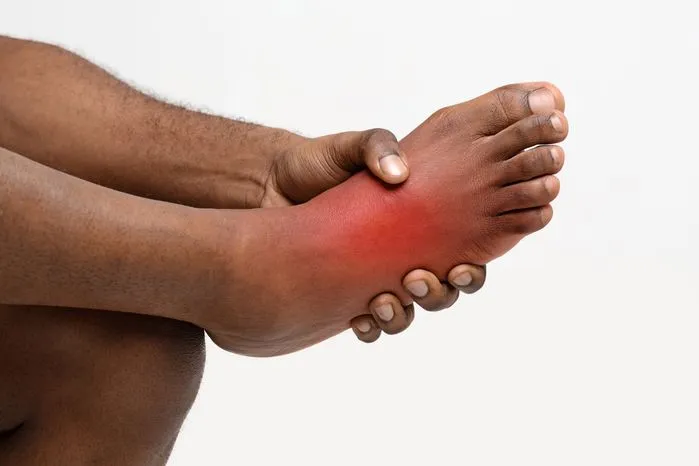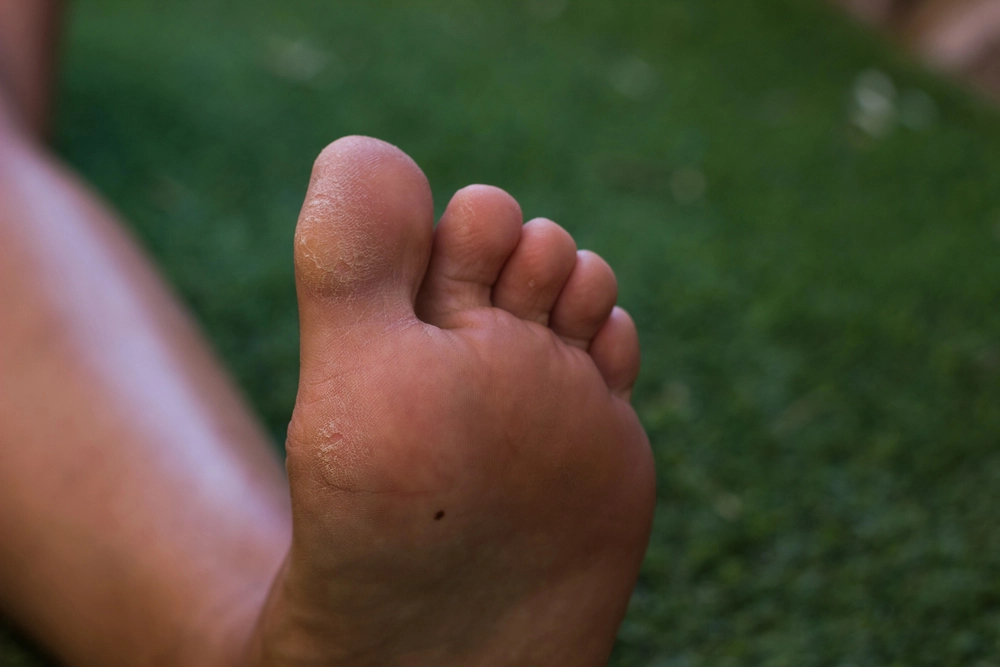
We’ve seen thousands of cases where patients mistake onychomycosis for something harmless—until it isn’t. At The Releford Foot and Ankle Institute, we don’t just define tinea unguium (onychomycosis)—we diagnose, treat, and track its real-world impact every day. This guide goes beyond textbook definitions to give you an insider’s view of how this stubborn nail infection presents in diverse patients, and why early, expert intervention can prevent chronic complications.
Top 5 Takeaways
1. It’s more than cosmetic.
- It causes pain, infection, and reduced mobility. It also impacts self-esteem.
2. Proper coding is key.
- Its accuracy ensures proper diagnosis, treatment, and insurance documentation.
3. Early care prevents bigger problems.
- Prompt treatment avoids nail loss, infection spread, and long-term damage.
4. Treatment must be comprehensive.
Includes:
- Topical/oral antifungals
- Possible nail removal
- Hygiene and prevention education
5. Real-world experience matters.
- Our care plans are based on treating thousands of real cases—not just textbook theory.
Understanding Onychomycosis (Tinea Unguium)
Primarily, Onychomycosis is an enduring, intricate fungal infection that mostly targets toenails, yet occasionally invades fingernails. Among diseases plaguing nails, this condition stands out as the most frequent, accounting for nearly half of all nail abnormalities. Variations in this disease can be identified by the affected nail part and the disease progression.
Its occurrence may lead to discomfort, pain, and even hinder walking abilities. Without prompt treatment, this infection could spread to surrounding nails or other individuals. Risk factors comprise advanced age, compromised health, nail injuries, warm environments, and using communal bath facilities.
Preventing it necessitates robust toenail care. Regular cleanliness habits, choosing breathable footwear, alongside avoiding communal footwear significantly diminish infection risks.
The ICD-10 Definition Unpacked
This tenth revision of the International Classification of Diseases provides a detailed system for categorizing health conditions, including Onychomycosis, under code B35.1.
'B' in this code stands for specific infectious and parasitic diseases. '35' points to dermatophytosis, referring to skin fungal infection. The '.1' immediately following the decimal point is a direct indication of Onychomycosis.
ICD-10's detailed coding facilitates diagnosis and treatment planning. Notably, to diagnose Onychomycosis under this system, one must confirm the presence of a fungal infection, typically through laboratory tests, affecting at least one nail.
Its Medical Implications
Known in the clinical world as a prevalent nail infection, it carries serious health implications that surpass mere aesthetic issues. Dermatophytes, yeasts, and non-dermatophyte molds primarily cause this fungal infection, leading to far-reaching health effects if left undiagnosed or untreated.
Complications can include pain, discomfort, and hindered ability to walk or use the hands. Extreme cases might even cause lasting nail damage or loss.
Secondary bacterial infections often follow its occurrence, escalating the risk of cellulitis, particularly in those suffering from conditions like diabetes or weakened immune systems. This fungal infection can also worsen skin conditions, such as psoriasis.
Not only does it lead to physical discomfort, but it also contributes to a reduced quality of life, affecting psychosocial well-being due to the stigma attached to its unappealing appearance. Stress, embarrassment, and social isolation can result from this condition.
Impact on Foot and Nail Health
It significantly affects foot health and nail appearance. The health implications of this infection range from discoloration to physical impairment.
- Discolored Nails: Patches of yellow, brown, or white often appear on nails affected by it. This discoloration, more than a mere cosmetic issue, signals a severe underlying fungal problem.
- Deformed Nails: Thickening and deformation of nails result from this infection, causing discomfort and pain, particularly during shoe wearing.
- Fungus Proliferation: If not treated, this fungal problem may spread to other toenails, foot skin, or even different body areas.
- Impaired Mobility: Pain and discomfort can hinder walking or standing for extended periods.
Treatment Options and Prevention
Two main strategies exist in managing it effectively: eradicating the infection and preventing recurrence. Treatment aims towards curing the fungal invasion causing this unpleasant condition. Topical or oral antifungal medications are common therapeutic methods, but removing the infected nail surgically might be required in more severe cases.
Yet, curing the infection isn't enough. Recurrence prevention is vital in dealing with onychomycosis. Such infections often result from exposure to damp, warm environments like communal showers or swimming pools.
Observing your nails regularly for infection signs and ensuring cleanliness and proper trimming form part of the prevention strategy. Antifungal sprays or powders provide further protection, along with breathable footwear, contributing to overall foot health.
"In over two decades of podiatric care, we’ve found that onychomycosis is one of the most frequently underestimated infections we treat—yet it’s rarely ‘just cosmetic.’ It’s a diagnostic and therapeutic challenge that requires precision, vigilance, and experience. At The Releford Foot and Ankle Institute, we don’t rely solely on textbook definitions—we rely on what we’ve learned from treating thousands of patients across all skin tones, ages, and comorbidities. The ICD-10 code B35.1 may define the condition clinically, but our job is to define its impact on real lives and prevent the cascade of complications that too often follow misdiagnosis or delayed care."
Supporting Facts and Statistics
We treat onychomycosis daily, and the numbers confirm what we see in our exam rooms. Here’s how national research backs up our clinical experience:
1. It’s More Common Than Most Realize
- Affects up to 14% of Americans
- Especially prevalent in seniors and patients with chronic conditions
- Often dismissed as “just nail discoloration”
- We regularly see patients who waited years to seek care—by then, multiple nails are involved.
🔗 cdc.gov
2. High-Risk for Diabetic Patients
- Diabetics face serious complications:
- Foot ulcers
- Bacterial infections
- Amputation risk
- Foot ulcers
- CDC warns nail fungus can escalate quickly if ignored
- We’ve treated diabetic patients with fungal nails that led to full-blown cellulitis and hospital stays.
🔗 cdc.gov
3. It Carries a Huge Economic Burden
- $6.7–$7.5 billion/year in direct costs
- Up to $48 billion with indirect impacts (missed work, productivity loss)
- Beyond medical bills, our patients lose time, confidence, and social freedom. The earlier we treat it, the cheaper and easier it is.
🔗 cdc.gov
Bottom Line:
These aren’t just statistics—they reflect the real-life challenges of our patients. At The Releford Foot and Ankle Institute, we combine diagnostic precision with lived clinical experience to treat the whole person, not just the nail.
Final Thoughts & Opinion
It may look minor—but after treating thousands of cases, we know better. We’ve seen how this stubborn fungal infection can lead to serious physical, functional, and emotional issues if not properly addressed.
Why It Matters
Too many patients mistake onychomycosis for a harmless cosmetic flaw. In practice, we’ve learned that it is persistent, progressive, and personal.
What Sets Our Approach Apart
Unlike generic advice, our treatment philosophy is grounded in experience:
- Early Diagnosis
- Spotting warning signs like discoloration and nail thickening
- Using lab tests for accurate coding
- Personalized Treatments
- Skillful medical professionals design your treatment for you.
- Recurrence Prevention
- Hygiene education
- Environmental and footwear guidance
- Long-term care tracking
Our Honest Opinion
Don’t let a thickened nail slide under your radar. Here’s our take:
- Superficial fixes don’t work—you need medical-grade care.
- Nail health is whole-body health—treat it with the respect it deserves.
- Proactive care beats reactive regret—every time.
Frequently Asked Questions
1. What is onychomycosis (tinea unguium)?
Onychomycosis, also known as tinea unguium, is a fungal infection of the nail, most commonly affecting the toenails. It causes the nail to become discolored, thickened, brittle, and crumbly over time.
2. What is the ICD-10 code for onychomycosis?
The ICD-10 code for onychomycosis is B35.1 — this code refers specifically to fungal infections of the nail caused by dermatophytes, yeasts, or molds.
3. What causes onychomycosis to develop?
It’s typically caused by dermatophytes (fungi that thrive in keratin), yeast (like Candida), or non-dermatophyte molds. Risk factors include poor foot hygiene, trauma, sweaty feet, communal showers, or a weakened immune system.
4. What does onychomycosis look like?
Signs include:
- Yellow, white, or brown discoloration
- Thickened, distorted nails
- Nail separation (onycholysis)
- Foul odor or crumbling edges
- The Releford Institute often uses clinical photos and microscopy to confirm diagnosis.
5. Is onychomycosis contagious?
Yes. It can spread through direct contact or by sharing nail clippers, shoes, towels, or walking barefoot in communal areas like pools or locker rooms.
6. How is onychomycosis diagnosed medically?
Diagnosis may involve:
- Visual examination
- Nail clippings sent for KOH prep, fungal culture, or PCR testing
- The Releford team emphasizes laboratory confirmation before starting systemic treatment.
7. What are the treatment options for onychomycosis?
Treatment depends on severity and may include:
- Topical antifungals (e.g., ciclopirox, efinaconazole)
- Oral antifungals (e.g., terbinafine, itraconazole)
- Laser therapy or nail debridement
- Systemic therapy is often more effective for moderate-to-severe infections.
8. How long does it take to cure onychomycosis?
Fungal nail infections are slow to resolve. Treatment usually lasts 6–12 weeks (oral meds) or up to 12 months (topical). Nail regrowth can take 9–18 months, depending on the location and severity.
9. Are there complications if onychomycosis goes untreated?
Yes. It can cause:
- Chronic pain or pressure while walking
- Secondary bacterial infections
- Nail detachment
- In diabetics, it can increase the risk of foot ulcers or cellulitis.
10. Can onychomycosis return after treatment?
Unfortunately, yes. Recurrence is common without ongoing foot hygiene, footwear disinfection, and preventive care. The Releford Institute recommends regular follow-ups and preventive topical agents post-treatment.
11. Who is most at risk for developing onychomycosis?
Higher-risk groups include:
- Older adults
- People with diabetes or circulatory issues
- Athletes or those with sweaty feet
- Immunocompromised individuals
12. How can I prevent onychomycosis in the future?
Follow these expert-backed prevention tips:
- Keep feet clean and dry
- Wear moisture-wicking socks and breathable shoes
- Avoid barefoot walking in public showers/pools
- Disinfect nail tools and change shoes regularly


















